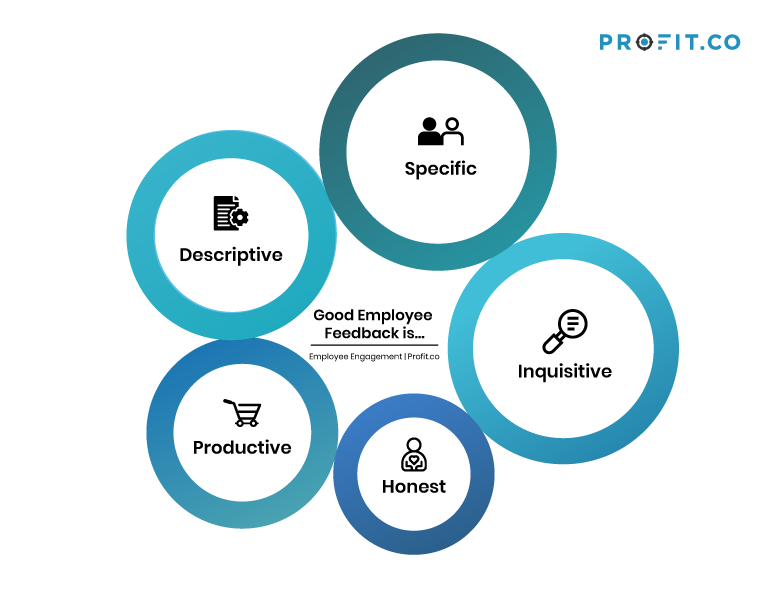Communication is essential in any workplace. Great feedback in the workplace is a key component of any professional relationship. However, giving feedback is a delicate art. Used appropriately, feedback can boost employee morale, productivity, and engagement. But if feedback is delivered poorly, it’s a recipe for disaster.
We want to transform workplace communication one step at the time. Starting with our top feedback dos and don’ts. So, if you’ve got an employee review on the horizon, stay tuned and take heed of the six constructive criticism examples to follow.
After reading this guide, you’ll be well on your way to providing effective, productive feedback that brings out the best in your employees.
Without further ado, let’s get going.
What is effective feedback?

Effective feedback occurs when information is shared and received in a respectful, productive manner. In other words, the aim of effective feedback is for the recipient to adjust their behavior or workplace practices in light of the information discussed.
The single most important thing to remember about effective feedback is that it should never take the form of judgement, mockery, or downright condemnation.
Feedback serves a productive purpose. To help an individual modify or improve something to generate a better outcome for everybody involved.
Improvement should always be the primary objective.
When giving feedback, aim to help the individual become a better employee without attacking who they are as a person. Feedback should never be personal.
When we say the word feedback, many people’s minds divert straight to criticism. But this need not be the case. We’ve got to revert our thinking. Instead, we should think of feedback as a process of improving the present for better outcomes in the future.
Instead of critical, feedback should be:
- Inquisitive
- Specific
- Descriptive
- Productive
- Honest
Feedback is all about unlocking somebody’s strengths, not highlighting their flaws.
But this is all easier said than done. Delivering feedback can be as nerve-wracking as receiving it. Many of us simply don’t know how to deliver feedback in an effective and personable manner.
But fear not, we’ve got some fantastic tips up our sleeve that will make you the best feedback-giver in the office.
How to deliver effective feedback
The key to effective feedback delivery is precision and production. That means specificity, immediacy, collaboration, and future-planning. Keep your feedback relevant, clear and offer actionable steps for improvement.
Act fast and be specific
Don’t wait too long to share your feedback. The feedback you offer should be fresh and relevant to recent events. For example, provide feedback to sales reps immediately after a call. Lay out what they did well and lay out your expectations for future performance. What could improve? How?
Act appropriately
Try to share feedback in a calm, positive, and professional manner. Choosing an appropriate location can help reinforce this. For example, it would be unkind to share negative feedback where other employees might overhear. And don’t lay it on too hard. Keep your feedback concise.
Don’t make it personal
No feedback – whether positive or negative- should be overly personal. Remember you are commenting on workplace behavior, not your employee’s personality. This is key to delivering professional feedback and your employee will be far more likely to make the necessary adjustments.
Keep language clear
Ensure that the language you use is clear and easy to understand. Your aim is to communicate with your employee – not to alienate them. Describe to your employee how certain behaviors impact performance and lay out the steps you want them to take in an objective manner.
Prepare evidence
It’s always a good idea to base your feedback on facts (not rumors). Showing data or evidence about an employee’s behavior or productivity from a variety of sources will give your feedback more staying power. For example, if an employee has continually failed to meet their sales quota then have quantitative evidence for this to hand.
Collaborate
Remember that giving feedback should not feel like a disciplinary meeting. A great way to foster a positive atmosphere is to engage in collaborative communication. Encourage your feedback recipient to ask questions and discuss any problems or concerns they may have. This will help you help them achieve more in the future.
Make feedback standard
One of the best ways to foster a culture of productive feedback in your workplace is to make feedback a standard procedure. Give feedback to every member of your team on a regular basis. That could be in the form of an informal check-in, or a performance review. This way feedback becomes a time to encourage engagement, idea sharing, and a culture of openness.
Make feedback normal. Not a performance review.
But what about criticism?
Giving criticism isn’t easy. But there are ways of offering constructive criticism that won’t destroy workplace relationships in the process. Below, we’ve outlined five fantastic constructive criticism examples that will keep team morale up and workflows going from strength to strength.
1. The Feedback Sandwich
Sandwich your constructive criticism between two positive remarks that focus on your employee’s strengths rather than their weaknesses.
For example:
You’ve been a great team player this month. I want us to work towards increasing your sales next month. Thank you for your hard work and commitment.
2. I, Not You
It often helps to speak in the first person. So say ‘I’ not ‘you’ as often as possible. This will make your conversation sound less accusatory.
For example:
Instead of saying you always show up to Friday meetings late, say I want you to show up to Friday meetings on time, is there anything that is making it difficult for you to do so currently?
3. Actionable Steps
Provide your employee with actionable steps and recommendations that they can act on to improve at work.
For example:
I think attending this training session will really help you improve your daily productivity.
4. No More Assumptions
Never rest on assumptions. Any criticism should be founded on reliable evidence from reputable sources.
For example:
BAD: Lucy from accounts said that you spend a lot of time sending personal emails
GOOD: Our system has flagged up an inappropriate level of personal computer use
5. Situation > person
Always focus more on the situation than the person. Criticism should not be a personal attack.
For example:
The presentation needed to include more data-led evidence. Next time, aim to include ten reputable sources.
Transform your workplace with effective feedback
Effective feedback is the lifeblood of any thriving workplace environment. Not only does it foster stronger professional relationships, but it helps recipients make actionable steps towards improvement. By following these effective feedback strategies you’ll be well on your way to enhancing your office communications. Remember feedback should always be productive, not personal.

